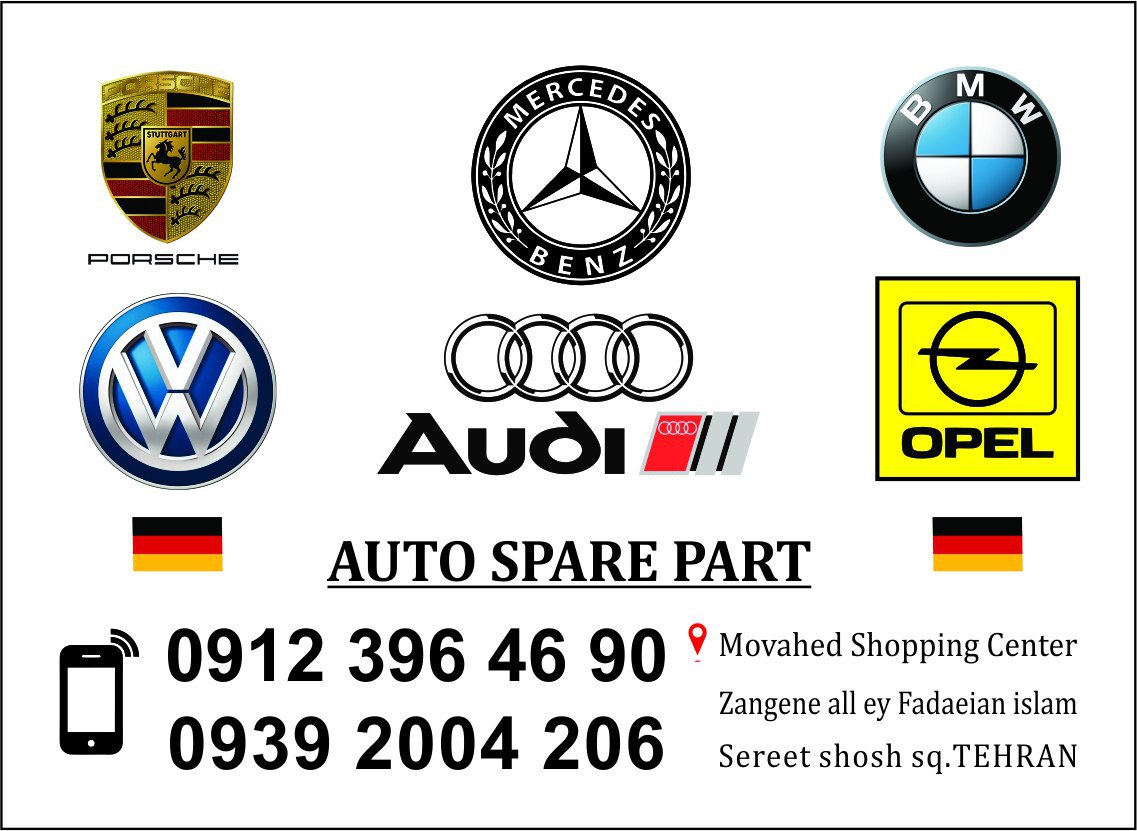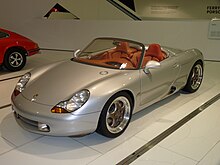تجربه رانندگی با پورشه باکستر
 نوشته: محسن آل طه و سجاد حیدری
نوشته: محسن آل طه و سجاد حیدری
عکس: بامداد صفائیان
مقدمه
پورشه؛ برندی که در ایران از محبوبیت خاصی برخوردار است و به دلیل چهره و قابلیت هایش، حساسیت خاصی نیز روی آن می باشد. اما هر آنچه باشد، پورشه در بین خودرو دوستان در جایگاه جدایی قرار دارد و هر مدلی از آن که به رقابتی وارد می شود، لرزه بر اندام تمامی شرکت کنندگان می اندازد. این برند آنچنان در ایران خوش درخشیده که با وجود ممنوعیت ورود خودروهای بالای 2500 سی سی، هنوز هم ورود بعضی مدل های جدید آن مانند پانامرا توربو مشاهده می شود و این نشان از تشنگی و عطش بازار برای چنین خودروهایی است.
در بین مدل هایی از پورشه که در زمان آزاد بودن ورود آنها توسط معین موتور وارد شد، باکستر را باید ارزان ترین و در عین حال یکی از خوش قیافه ترین آنها بدانیم. فرزندی از اشتوتگارد که این روزها با وجود گذشت چند سال از ورودش به بازار ایران، هنوز هم با گذرش از خیابان تمام چشم ها را به سوی خود می چرخاند و صدای طنین انداز اگزوزش می تواند خط و نشانی برای تازه واردهای پرمدعا بکشد.
چند وقت پیش با مساعدت و همکاری یکی از دوستان فرصتی دست داد تا این کروک زیبا را به صورت دقیق تری مورد بررسی قرار دهیم و از نزدیک با قابلیت های آن آشنا شویم.
طراحی داخلی و خارجی
اصالت، دقیقاً همان چیزی است که شرکت خودروسازی پورشه آن را درک میکند و هنوز هم بعد از گذشت سالیان سال به آن پایبند بوده و از آن استفاده میکند و میتوان این خصلت را در طراحی ظاهری محصولات تولیدیاش احساس کرد. پورشهباکستر نیز از این قاعده مستثنی نبوده و همچون برادرانش، خصوصیات پدران خود را در فرم خاص بدنه و سایر قسمتها به ارث برده است، ولی این حفظ اصالت و شباهتها با سایر مدلها دردسرهای خاص خود را دارد و آن هم تشخیص و تفکیک مدلهای کوچک آن از یکدیگر است و اگر اهل فن نباشید و چندان اطلاعی از مدلهای مختلف این کمپانی نداشته باشد، تشخیص مدلهایی همچون 911، باکستر یاکیمن با یکدیگر برایتان اندکی مشکل خواهد شد.
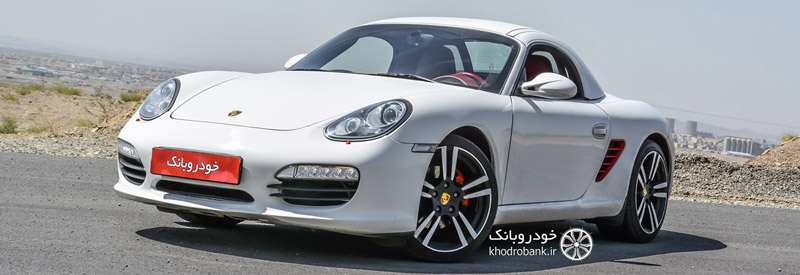
پورشه باکستر مورد بررسی ما نیز از لحاظ طراحی شباهت زیادی در نگاه اول به برادر خود یعنی کیمن دارد که در اینجا علاوه بر بررسی طراحی این اسب اشتوتگاردی، در مورد تفاوتهای این دو مدل هم بحث خواهیم کرد.
اولین چیزی که در دو پورشه باکستر و کیمن با یکدیگر تفاوت دارد و میتوان مهمترین معیار تفکیک و تشخیص این دو مدل باشد، سقف این دو و مکانیزم ساخت آنها با یکدیگر است، چون پورشه باکسترهای موجود در ایران و جهان تنها با سقف متحرک (کروکی) ساخته میشوند و پورشههای کیمننیز با سقفی ثابت بر سر خود تولید میشوند. البته در تصاویری که هنگام تست از این باکستر گرفته شده، گمان میرود که سقف آن ثابت باشد، ولی شایان ذکر است که مالک خودرو برای افزایش طول عمر سقف پارچهای ماشین خود، سقفی هم رنگ بدنه را بر روی آنها قرار داده که میتوان با دست هم آنها را جدا کرد و سقف خودرو را به داخل شاسی هدایت کرد و از طبیعت و هوای آزاد لذت برد.
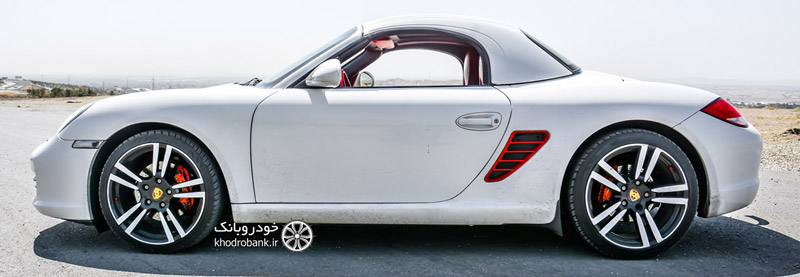
در بخش جلویی خودرو نیز طراحان از چراغهای سنتی معروف با دو لامپ اصلی روشنایی در هر قاب استفاده کردهاند که از لحاظ طراحی و الگوها، دقیقاً شبیه به چراغهای پیشانی پورشهکیمن هستند، ولی اگر کمی پایینتر بیاییم، شاهد مه شکنهای متفاوتی در بخش بالایی ورودیهای هوای دو طرف سپر خواهیم بود که در پورشه باکستر این مه شکنها به صورت نواری و مستطیل شکل کشیده شده بوده و تمامی بخش بالایی این ورودیها را اشغال کردهاند، ولی در پورشهکیمن تنها از مه شکنهایی ساده گردی شکل در دو گوشه بیرونی هر دو ورودی هوا استفاده شده است.
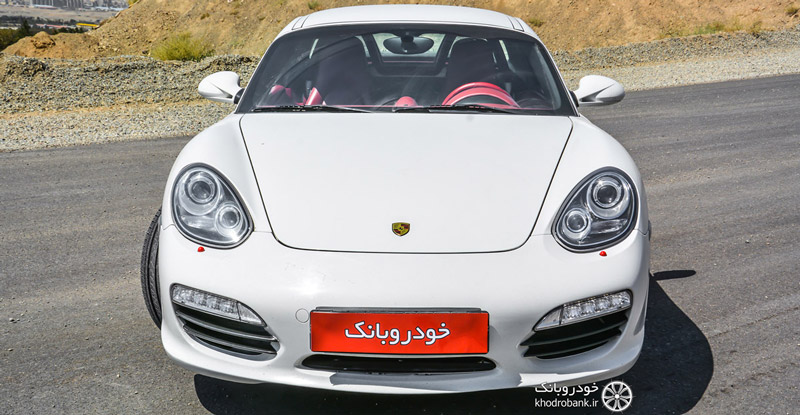
مجموعه سپر نیز خود میتواند معیاری برای تشخیص این دو مدل باشد، چون پورشه کیمن دارای ورودیهای بیشتر و بزرگتری در بخش مرکزی سپر است، در غیر این صورت دیگر قسمتها و بخصوص فرم بدنه هر دو خودرو و حتی آینههای جانبی و ارتفاع هر دو مدل، شباهتی مویرگی به یکدیگر دارند.
در قسمت عقب خودرو نیز با این معضل رو به رو هستیم و به غیر از اسپویلر یا همان باله بزرگ آیرودینامیکی نصب شده در انتهای سپر کیمن (پورشه باکستر اسپویلری متحرک دارد)، چراغهای عقبی تمام LED هر دو مدل شبیه به یکدیگر هستند و خروجیهای اگزوز هر دو مدل نیز به صورت گردی شکل دوبل کنار هم در مرکز شاسی و در زیر سپر نصب شدهاند، ولی خروجیهای مدل کیمن کمی بزرگتر بوده و برخلاف رنگ کرومی اگزوزهای باکستر، به رنگ مشکی مات (در پورشهکیمن) درآمدهاند.

دیفیوزر زیر سپر هر دو مدل هم در یک موقعیت طراحی شدهاند، ولی تفاوتهایی در ساختار و طراحی آنها دیده میشود. به طور کل میتوان گفت که پورشه باکستر و کیمنهر دو بر روی یک پلتفرم مشترک توسعه یافتهاند، با این تفاوت که پورشه باکستر سقفی متحرک دارد.
طراحی داخلی این دو نسخه از پورشه را اگر بگوییم کپی-پیست یکدیگر هستند, شاید باورتان نشود، ولی با یک اختلاف خیلی جزئی در صفحه کیلومتر، واقعاً شبیه یکدیگر می باشند.
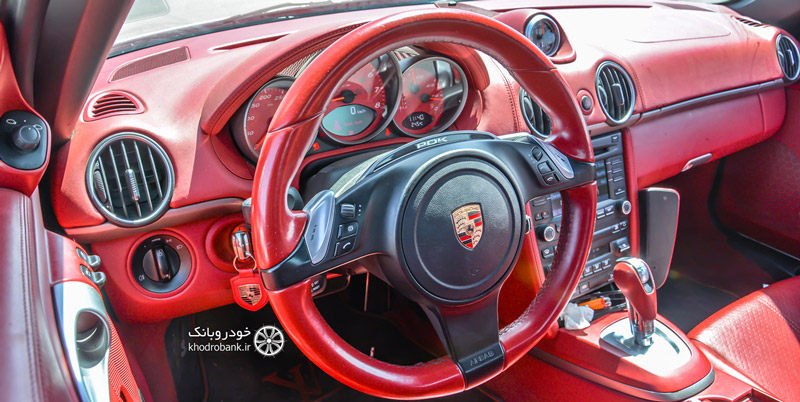
وقتی برای اولین بار وارد کابین پورشه باکستر شدیم، اول از همه با غربیلک فرمان برخورد داشتیم که دارای سه پایه اصلی بوده و توسط چرمهای مرغوبی روکش شده بود و به عنوان اولین و مهمترین قطعهای که رابطه مستقیم با راننده دارد، حس خیلی خوبی را به راننده منتقل میکند که به طور دقیقتر میتوان گفت، با شگل ارگونومیک که دارد، حس و حال اتومبیلهای اسپرت و همچنین با روکشهای چرمی و کلیدهای سیستم چندرسانهای که بر روی خود دارد، حس وحال اتومبیلهای لوکس را به راننده منتقل میکند.
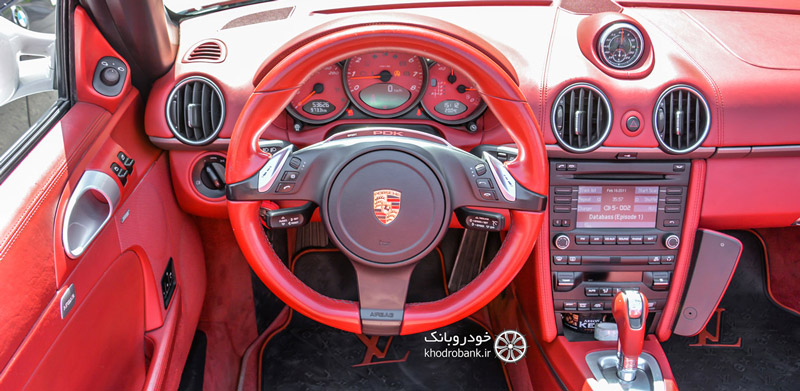
البته نباید این وسط منکر طراحی تکراری آن شد. در پشت غربیلک فرمان نیز صفحه کیلومتر خودرو قرار گرفته که به صورت سنتی و عقربهای طراحی شده تا با خلق و خوی اسپرتی این باکستر کوچک همخوانی داشته باشد. مهمترین تفاوتباکستر با کیمن در فضای داخلی کابین مربوط به همین صفحه کیلومتر میشود. البته الگوهای طراحی هر دو مدل شبیه به یکدیگر است، ولی قطعهای که مثل سایهبان بر روی نشانگرها قرار گرفته است، متفاوت با صفحه کیلومتر کیمن است و قوسی یک تکه و متوالی دارد. از دیگر بخشهای کابین هم راستش را بخواهید انتظار بیشتری داشتیم و با اسم و رسمی که پورشه برای خود دست و پا کرده است، حداقل انتظار یک داشبورد و کنسول مرکزی زیباتری را داشتیم که خوشبختانه با روکشهای چرمی قرمز رنگی که در این مدل بر روی آنها کشیده شده بود، میشد نمره قبولی را به فضای داخلی کابین داد، هرچند این طراحی به بهانه حفظ اصالت که پورشه بر روی موج آن سوار شده است، در مدلهای بعدی مورد استفاده قرار نگرفته و یک مجموعه داشبورد و کنسول مرکزی بهتر برای این کوچولوی دوست داشتنی پورشه (در مدلهای بعدی) طراحی شده است.
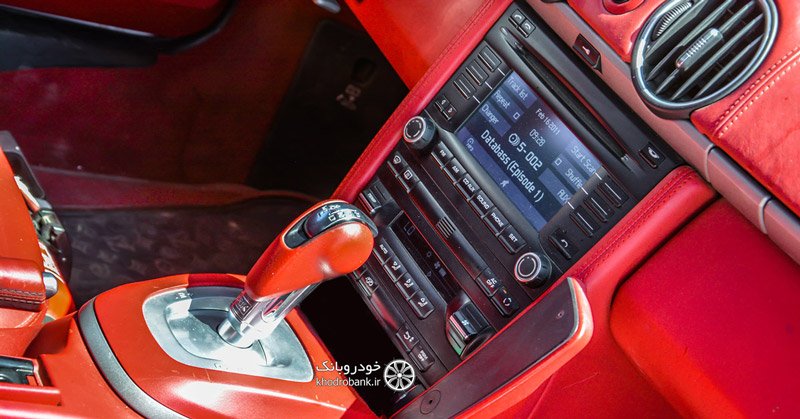
بر روی پنل دربها نیز طراحان از دو بلندگو استفاده کردهاند که صدایی بلند و فراگیر دارند و دیگر نیازی به نصب سیستمهای صوتی جداگانه نخواهید داشت. سوئیچ روشن و خاموش موتور هم بجای سمت راست (مرسوم در تمامی اتومبیلها) در سمت چپ غربیلک فرمان نصب شده که برای راست دستهایی مثل ما، کمی متفاوت و جالب بود.
امکانات رفاهی و آپشنها
در این بخش معمولاً شرکتهای اروپایی لیست بلند بالایی از تجهیزات و آپشن را در خودروهای تولیدی خود بکار میبرند و کمپانی پورشه و باکستر نیز از این قاعده مستثنی نیست، به همین دلیل تا جایی که بحث از حوصله خارج نشود و لب مطلب هم گفته شود، به طور خلاصه به معرفی سیستمهای مختلف نصب شده بر روی پورشه میپردازیم، به این صورت که بر روی پورشه باکستر از 2 عدد کیسه هوای ایمنی برای راننده و سرنشین، سیستمهای پایداری PSM، ABD، MSR،ASR و ABS در بخش پایداری و کمک راننده، قفل مرکزی و ریموت کنترل اخطار دهنده، سیستم کلید ضد سرقت و ورود و خروج و روشن کردن موتور بدون کلید در بخش سیستمهای امنیتی و حفاظتی، سیستم فرمان هیدرولیکی به همراه سیستم کمکی الکترونیکی و سیستم حساس به سرعت، سیستم تهویه مطبوع اتوماتیک دارای سیستم کنترل کیفیت هوا، سیستم صوتی حرفهای با قابلیت پخش CD و DVD مجهز به پورتهای USB و AUX و آیپاد کابل، نمایشگر چند منظوره اطلاعات سفر و راننده مجهز به مکان یاب ماهوارهای و بلوتوث و ... صندلیهای اسپرت سفارشی با تنظیم کننده گودی مهرههای کمر و سیستم حافظه یکپارچه روکش شده توسط چرم و مجهز به پشت سریهای فعال جهت جلوگیری از صدمات وارده در هنگام تصادف، آینههای وسط الکتروکرومیک که هنگام شب چشمهای راننده را به خاطر چراغهای اتومبیلهای پشت سری خسته نمیکند و آینهای جانبی مجهز به گرمکن، سنسور باران، سنسور پارک، سیستم کروز کنترل و.... نصب شده است.
مشخصات فنی
پیشرانه، قلب تپنده هر اتومبیلی است که در پورشه باکستردارای شش بطن مجزا بوده و حیات اتومبیل به حرکت پیستونها در آن بستگی دارد. پیشرانهای شش سیلندر 24 سوپاپ بوکسر تخت بنزین سوز با حجم دقیق 2893 سی سی و مجهز به انژکتورهای پاشش مستقیم سوخت موتور میانی که در اصل در نیم تنه عقبی اتومبیل نصب میشود، ولی چون در جلوی محور عقب نصب شده، به آن موتور میانی میگویند. ولی برای کیمن S موجود در کشور، یک پیشرانه قویتر یعنی یک موتور شش سیلندر تخت 3.5 لیتری در نظر گرفته شده است. البته معین موتور نماینده پورشه در ایران، تنها اقدام به واردات همین دو اتومبیل با حجم موتور 2.9 لیتری و 3.5 لیتری کرده بود که حالا واردات آن متوقف شده است.
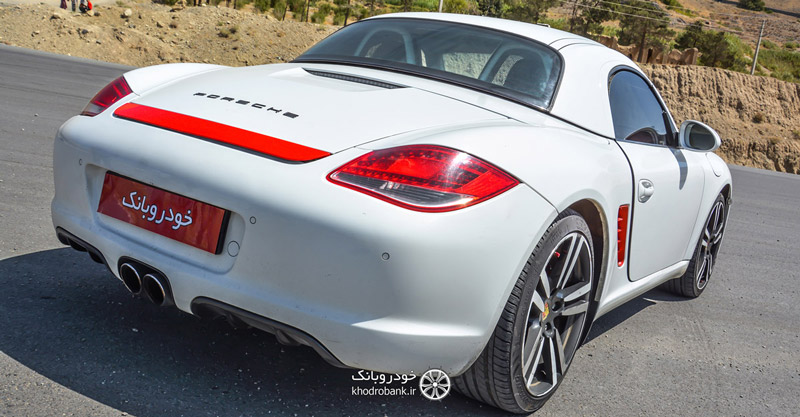
در بیشتر موتورهایی که بر روی خودروها نصب میشود، محفظه روغن و کارتل در پایینترین قسمت موتور نصب شده و به ترتیب که بالاتر میرویم، میل لنگ، شاتون، پیستون و در آخر هم سرسیلندر پدیدار میشود، ولی موتورهای "باکسر" یا "بوکسر" مورد استفاده بر روی اتومبیلهای کوچک پورشه همچون کیمن و 911 و باکستر، کمی متفاوتتر از بقیه پیشرانهها هستند و به شکلی تخت یا خوابیده ساخته میشوند، یعنی میل لنگ در وسط قرار گرفته و پیستونها و شاتون به صورت افقی، چهار سیکل مکش، تراکم، انفجار و تخلیه را انجام میدهند که مهمترین مزیت آنها حجم کمتر نصب به سایر پیشرانههای مرسوم است که برای پورشههای ذکر شده بهترین گزینه به شمار میرود، در ضمن در موتورهای خطی و یا V شکل هنگام کار کرد موتور، مقداری لرزش به دلیل تغییر مسیر گشتاور و رفت و برگشت سیلندرها وجود دارد که شرکتهای سازنده برای از بین رفتن این لرزشها، وزنههایی موسوم به "لنگ" را به میل لنگ اضافه میکنند که باعث سنگین شدن میل لنگ و در نتیجه تعادل بهتر میل لنگ در هنگام میشود، اما این وزنهها هم باعث از دست رفتن مقداری نیرو و همچنین تولید دمایی بیشتر میشوند، ولی در موتورهای باکسر به دلیل افقی نصب کردن سیلندر و پیستونها به صورت مخالف ، هر سیلندر خود به عنوان یک لرزش گیر یا وزنه "لنگ" عمل کرده و دیگر اجازه لرزش را به قطعات متحرک موتور نمیدهند. ولی از قدیم گفتند که هر چیز خوبی، یک ایراد هم دارد و ایراد موتورهای خوابیده باکسر نیز خنک کاری و روغن کاری دشوار این موتورهاست که در نتیجه به غیر از شرکت هایی مثل پورشه و سوبارو که در این بین از تکنولوژی بالایی برخوردارند، منجر به روی برگرداندن شرکتهای بزرگ خودروسازی برای استفاده از آنها (موتورهای خوابیده) شده است.

این نوع موتور نیز برای اولین بار در سال 1896 میلادی توسط کارل بنز ساخته شد و در سال1923 شرکت بیامو آلمان، موتور باکسر دو سیلندری 500 سی سی را ساخت که روی موتور سیکلتهای ساخت این شرکت نصب میکرد که با هوا خنک میشد. بعدها کمپانی سیتروئن و فولکس واگن نیز از این موتور استفاده کردند. البته موتوری که فولکس طراحی کرد با هوا و روغن خنک میشد و بر روی مدل مشهور بیتل یا قورباغهای مورد استفاده قرار گرفت.
بر روی پورشه باکستر همانطور که گفتیم، از همین نوع پیشرانههای خوابیده استفاده کردهاند که از نوع شش سیلندر 24 سوپاپه، یعنی 4 سوپاپ گاز و دود برای هر سیلندر بوده و در حجمی 2.9 لیتری (2893 سی سی) به همراه انژکتورهای پاشش مستقیم سوخت و نسبت تراکمی 11.5:1 ساخته شده است که با تزریق 8.7 لیتر سوخت در مسیرهای خارج از شهر و 12.4 لیتر سوخت در مسیرهای شهری، میتواند حداکثر 256اسب بخار قدرت با رساندن دور موتور بر روی 6400 دور بر دقیقه و همچنین 290 نیوتن متر گشتاور در محدوده دور 4400 الی 6000 دور بر دقیقه تولید کند که بر روی کاغذ، شتاب صفر تا صد 5.9 ثانیهای و حداکثر سرعتی 263 کیلومتر بر ساعتی را به ثبت رسانده است.
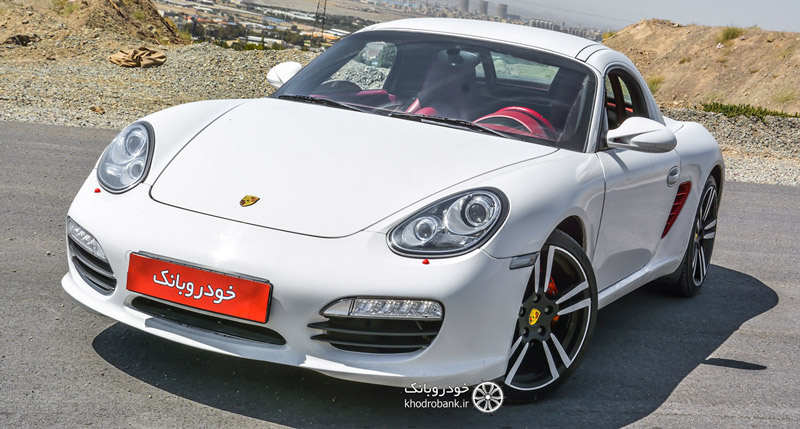
برای دریافت و تبدیل دور نیز از جعبه دندهای 7 سرعته اتوماتیک مشابه با گیربکس کیمن S استفاده شده است، جعبه دنده اتوماتیک با قابلیت تعویض دنده دستی از خانواده PDK(بر روی غربیلک فرمان هم میتوان حروف PDK را که مربوط به جعبه دنده میشود، مشاهده کرد) که در 7 سرعته متوالی به همراه کلاچ دوگانه توسعه و ساخته شده که با سرعتی بالا و بدون وقفه در جریان انتقال قدرت عمل تعویض دنده را انجام میدهد که موجب شتاب بالا و کاهش مصرف سوخت و صد البته افزایش سطح رفاهی و کاهش کله زنی خودرو در هنگام تعویض دنده میشود.
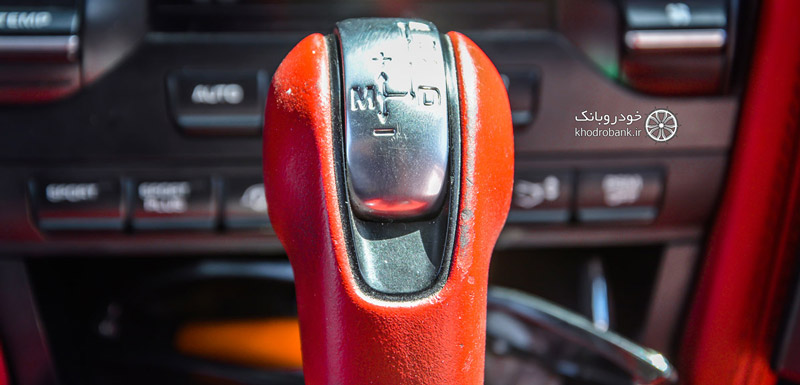
برای مهار قدرت 256 اسب بخاری پیشرانه که روانه چرخها میشود، پورشه بر روی چرخهای جلویی و هم برای چرخهای عقبی از ترمزهای دیسکی خنک شونده با هوا استفاده کرده است که هر دو در مدل باکستر اندازهای 350 میلی متری دارند، ولی برای دیسکهای جلویی شش پیستون با کالیبراسون قرمز رنگ و برای دیسکهای عقبی هم چهار پیستون آلومینیومی با کالیبراسون مشابه در نظر گرفته شده که در کنار سیستمهای پایداری و کمک راننده نظیر سیستم ترمز ضدقفل ABS، سیستم کنترل لغزش ASR، سیستم جلوگیری از هرز گردی ABD و سیستم مدیریت ایمنی فرایند PSM، ایمنی این سیستم را چندین برابر کردهاند. سیستم فرمان هوشمند الکترونیکی با قدرت کمکی هیدرولیکی و مجهز به سیستم حساس سرعت و قابلیت تنظیم به صورت برقی در کنار سیستمهای تعلیق دوجناغه مستقل برای محور جلو و همچنین سیستم تعلیق مولتی لینک یا چند اتصاله برای محور عقب، آرامش و عکس و العمل سریع نسبتا نرمی را برای باکستر به همراه داشته است.
تجربه رانندگی
بالاخره کلید را چرخانده و موتوری که در پشت سرم قرار گرفته را روشن می کنم. از همان ابتدا غرش سنگینی از عقب و از سوی خروجی اگزوز تمام محیط را می لرزاند تا نشان دهد که هنوز هم برای جنگ های خیابانی آمادگی کاملی دارد. قبل از شروع حرکت سعی می کنم از همین لذت اولیه استفاده کرده و چند باری دور موتور را تا نزدیک خط قرمز می برم تا از صدای ایجاد شده به همراه تمام دوستانی که با من به این تست آمده اند، لذت ببرم.
بالاخره شروع به حرکت می کنم. با وجود اینکه نزدیک 56 هزار کیلومتر کارکرد این اشتوتگاردی خوش قیافه است اما هنوز هم سرحال و آماده است و هیچ خستگی در حرکت آن دیده نمی شود. محل قرار گیری راننده در خودرو آنچنان پایین است که حتی پژو 206 نیز در کنار شما همانند یک شاسی بلند خواهد بود(!) اما همین نوع قرارگیری باعث می شود هندلینگ بسیار خوبی را برای شما داشته باشد و کنترل بسیار خوبی سر پیچ ها بر روی خودرو داشته باشید.

وقتی پشت یک آلمانی با موتور وسط و دیفرانسیل عقب نشسته اید، مطمئن باشید ناخودآگاه دوست دارید به خودرو فشار بیاورید و پدال گاز را تا آنجایی که جا دارد بفشارید. با اجازه صاحب خودرو حسابی از خجالت خودرو در می آییم و لذت سواری واقعی با یک پورشه را تجربه می کنیم. قدرت موتور آنچنان است که زمان تعویض دنده از 2 به 3 نیز دوباره شما را به صندلی می چسباند و غرش اگزوز لبخند رضایت را بر لبان شما نقش خواهد بست.
البته ما به این کارها نیز راضی نبودیم و با انجام حرکت دونات حق مطلب یک دیفرانسیل عقب 256 اسبی را ادا کردیم.
ترمزهای این خودرو همانند پیشرانه اش قدرتمند هستند و بعد از تمامی توضیحاتی که در مورد آنها دادیم، باید گفت که عملکرد آنها نیز بسیار خوب است و به راحتی از پس موتور برمی آید.
قیمت و نتیجه گیری
اگر به بازار آزاد برویم متوجه می شویم که هم اکنون مدل های 2010 تا 2012 باکستر وجود دارد که قیمت آنها بین 250 تا 310 میلیون تومان است. درست است که هزینه های نگهداری باکستر کمی بالا است ولی لذت رانندگی، هندلینگ فوق العاده و موتور قدرتمند آن چنان است که شاید خودرو دوستانی مثل من حاضر باشند تمامی هزینه ها را به جان بخرند و در عوض یک آلمانی دو درب با موتور باکسر پورشه را سوار شوند.
| پورشه باکستر | |
| مثبت | کیفیت ساخت، طراحی ظاهری خاص، هندلینگ مناسب، موتور قدرتمند |
| منفی | هزینه بالای نگهداری، نبود فضا برای 4 نفر، نبود نمونه صفر کیلومتر |
| مشخصات فنی | |
| مدل | پورشه باکستر |
| پیشرانه | 6 سیلندر 2.9 لیتری |
| حجم موتور | 2893 سی سی |
| قدرت | 256 اسب بخار در 6400 |
| گشتاور | 290 نیوتن متر در 4400 |
| شتاب | 5.9 ثانیه |
| حداکثر سرعت | 263 کیلومتر |
| وزن | 1410 کیلوگرم |
| قیمت بازار | 00000000000000 |
عکس ها:
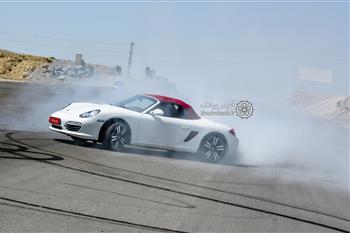 | 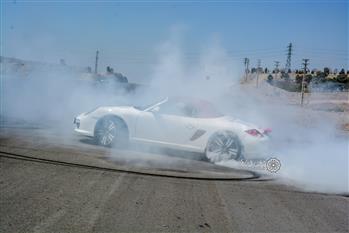 | 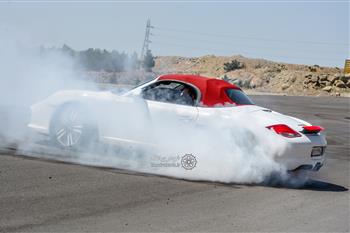 |  | 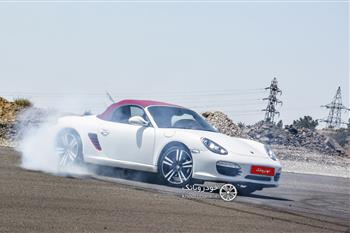 | 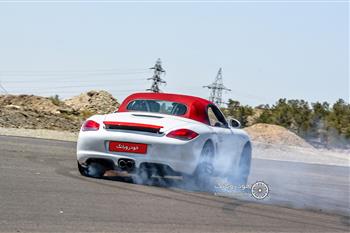 |
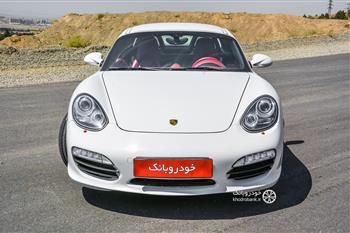 |  | 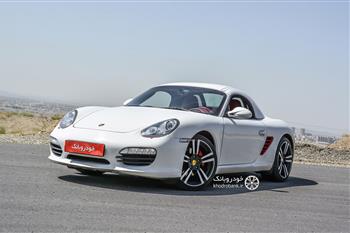 |  |  | 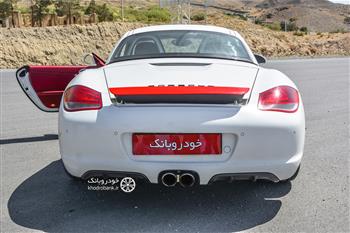 |
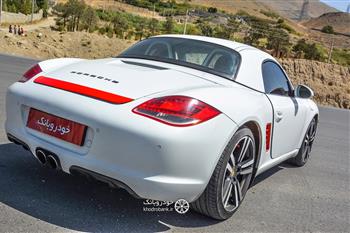 | 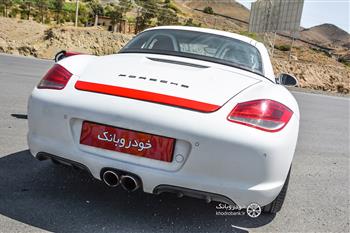 | 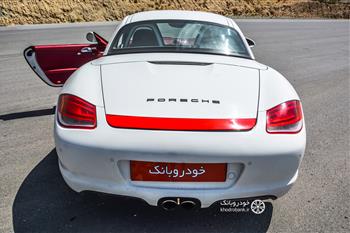 | 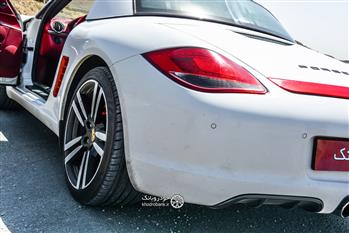 | 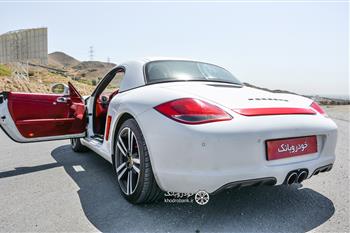 | 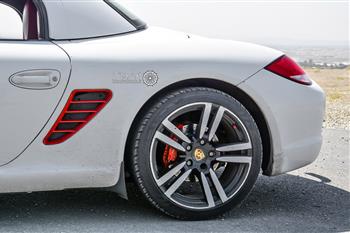 |
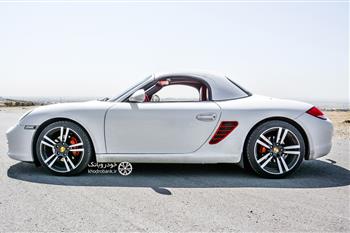 | 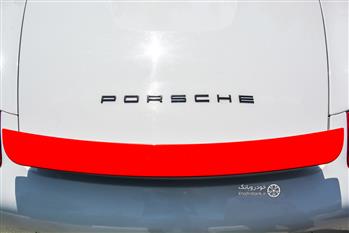 | 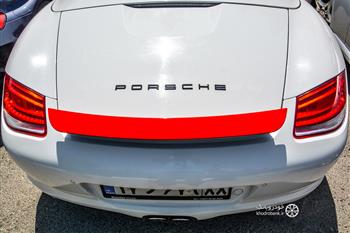 | 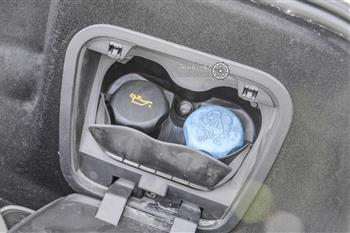 | 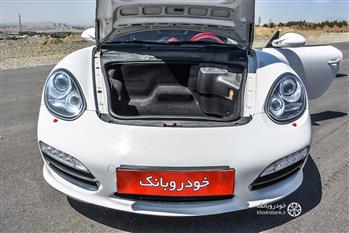 | 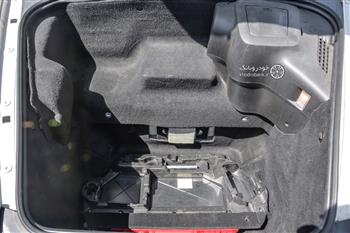 |
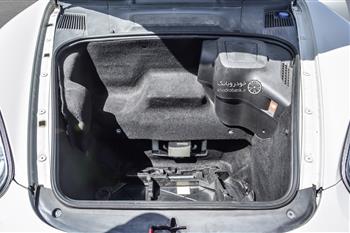 | 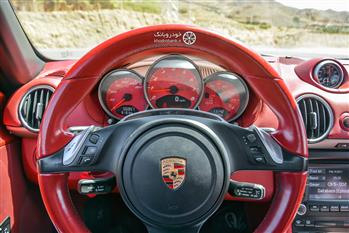 |  | 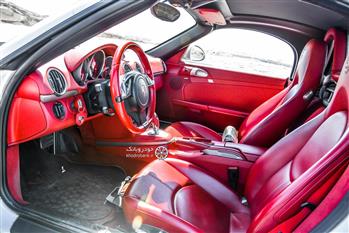 |  | 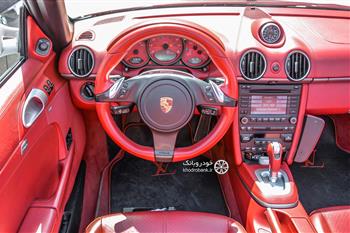 |
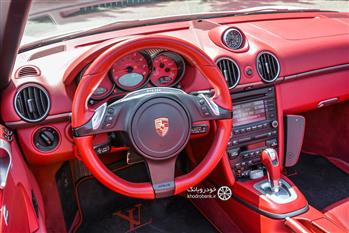 | 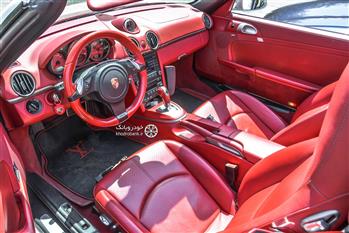 |  | 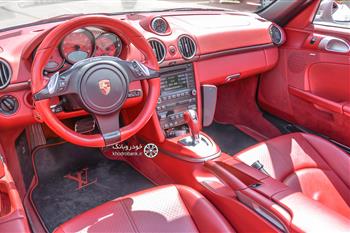 | 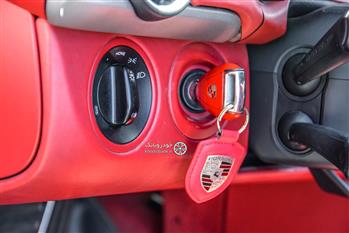 | 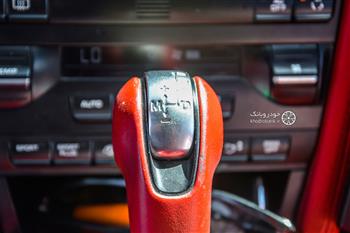 |
 |  | 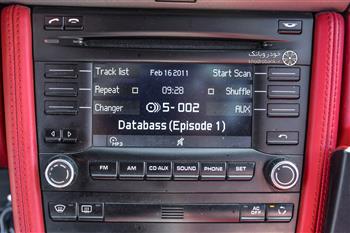 | 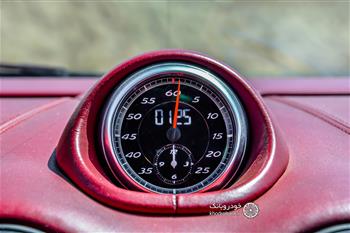 | 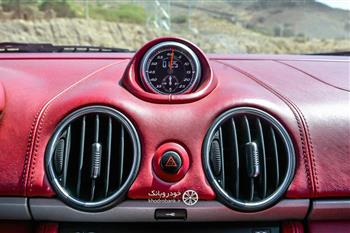 | 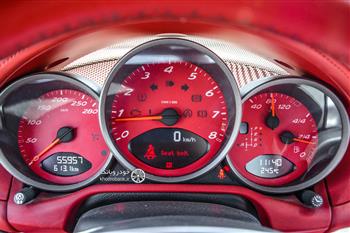 |
 | 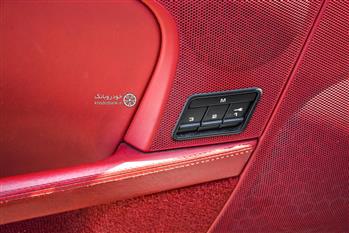 | 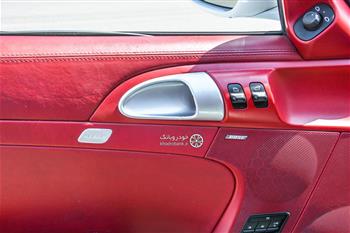 | 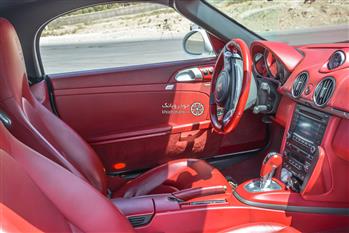 | 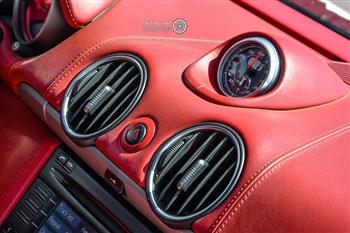 | 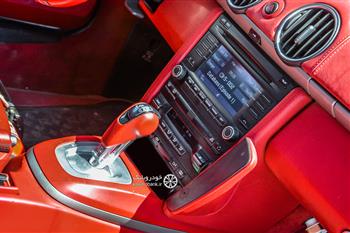 |
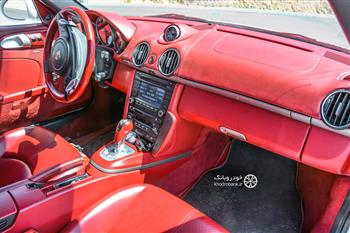 | 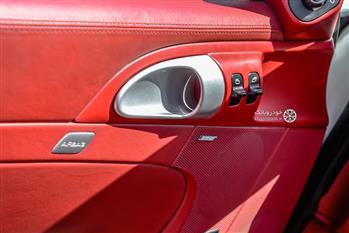 | 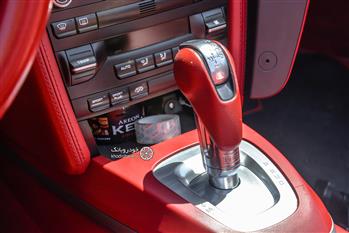 | 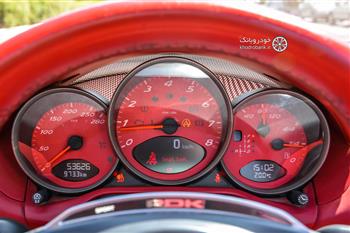 | 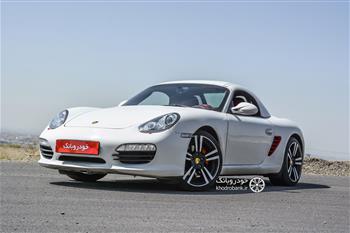 | 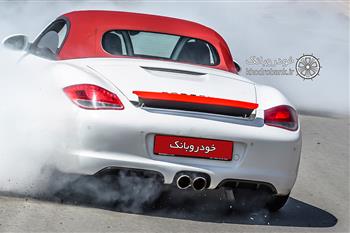 |
Wikipedia:
Porsche Cayman
Porsche 718OverviewManufacturerAlso calledProductionModel yearsAssemblyBody and chassisClassLayoutRelatedChronologyPredecessor
 Porsche 718 Boxster (982) Porsche 718 Boxster (982) | |
 Porsche 718 Cayman (982) Porsche 718 Cayman (982) | |
| Porsche AG | |
| Porsche Boxster Porsche Cayman Porsche 718 Boxster Porsche 718 Cayman | |
| 1996–present | |
| 1997–present | |
| |
| Sports car (S) | |
| Rear mid-engine, rear-wheel drive | |
| |
| Porsche 968 | |
The Porsche Boxster and Porsche Cayman are mid-engined two-seater sports cars manufactured and marketed by German automobile manufacturer Porsche across four generations — as a 2-door, 2-seater roadster (Boxster) and a 3-door, 2-seater fastback coupé (Cayman).
The first generation Boxster was introduced in 1996; the second generation Boxster and the Cayman arrived in late 2005; and the third generation launched in 2012. Since the introduction of the fourth generation in 2016, the two models have been marketed as the Porsche 718 Boxster and Porsche 718 Cayman.
The Boxster and Cayman have been manufactured in Stuttgart (Zuffenhausen), Germany (1996–present) as well as Uusikaupunki, Finland by Valmet (1997–2011) and Osnabrück, Germany (2012–present).
The nameplate Boxster is a portmanteau of boxer, a reference to its flat or boxer engine, and roadster, a reference to the body style. The nameplate Cayman is an alternative spelling of caiman, a member of the alligator family.
Contents
- 1Overview
- 1.1Boxster
- 1.2Cayman
- 1.3718
- 2First generation: Boxster (986) (1996–2004)
- 3Second generation: Boxster/Cayman (987) (2005–2012)
- 4Third generation: Boxster/Cayman (981) (2012–2016)
- 5Fourth generation : 718 Boxster/Cayman (982) (2016–present)
- 6Motorsport
- 6.1Boxster
- 6.2Cayman
- 7Awards
- 8Mechanical issues and lawsuit
- 9References
- 10External links
Overview[edit]
Boxster[edit]
The Porsche Boxster is a mid-engined two-seater roadster. It was Porsche's first road vehicle to be originally designed as a roadster since the 550 Spyder. The first-generation Boxster (the 986) was introduced in late 1996; it was powered by a 2.5-litre flat six-cylinder engine. The design was heavily influenced by the 1992 Boxster Concept. In 2000, the base model was upgraded to a 2.7-litre engine and the new Boxster S variant was introduced with a 3.2-litre engine. In 2003, styling and engine output was upgraded on both variants.
Production of the 986 began at the former Porsche 928 facility in Stuttgart, Germany in 1996. Valmet Automotive also manufactured Boxsters under contract to Porsche at a facility in Uusikaupunki, Finland. The Boxster was Porsche's biggest volume seller from its introduction in 1996 until the company introduced the Cayenne sport utility vehicle in 2003. As of September 2012, additional production of the 981 started at the former Karmann-factory in Osnabrück.[2]
In 2005, Porsche debuted the second generation of Boxster, the type 987, with a more powerful engine and styling inspired by the Carrera GT. Engine output increased in 2007, when both Boxster models received the engines from their corresponding Porsche Cayman variants. In 2009, the Boxster models received several new cosmetic and mechanical upgrades, further increasing engine output and performance. The third generation Boxster (type 981) was launched at the 2012 Geneva Motor Show.
The Boxster's name is derived from the word "boxer", referring to the vehicle's flat or "boxer" engine, and the word "roadster", referring to the vehicle's two-seater capacity and convertible top.
Cayman[edit]
First launched in the 2006 model year, the Cayman is a coupé derived from Porsche's second and third generation Boxster roadster, styled in its first iteration by Pinky Lai.[citation needed] A large percentage of the Boxsters were assembled in Finland for Porsche by Valmet Automotive with others assembled in Zuffenhausen, Stuttgart. All Caymans were manufactured in Finland by Valmet Automotive. Porsche's Deputy Chairman, Holger P. Haerter said the contract with Valmet Automotive would end in 2012, and the Cayman's production was to be outsourced to Magna Steyr in Graz, Austria.[3] As Volkswagen assumed control of Porsche AG, production of Caymans and Boxsters after 2012 began in the former Karmann plant in Osnabrück, Germany, at the time owned by Volkswagen and also used for production of the 2012 Golf (Mk6) convertible.[4]
The car is not named after the Cayman Islands. Both the car and the islands are named after the caiman, a member of the alligator family. When the first Caymans arrived at dealerships for sale, the automaker adopted four caimans at Stuttgart's Wilhelma Zoo.[5]
Porsche brought an infringement lawsuit in 2009 against Crocs, the maker of the popular rubber shoes. At issue was the footwear company's clog name also called Cayman. An injunction was granted against Crocs Europe, a division of the Longmont, Colorado-based shoe company preventing their use in Germany of the Cayman name.[6]
718[edit]
Introduced in 2016 for the 2017 model year, the Porsche Boxster and Cayman were renamed the Porsche 718 Boxster and Porsche 718 Cayman, reviving the historic 718 moniker while switching engines from naturally-aspirated flat sixes to small-displacement flat-four turbocharged units. The new 718 Cayman was also repositioned with an entry price lower than that of the 718 Boxster, in keeping with Porsche's higher pricing for roadster models.[7]
First generation: Boxster (986) (1996–2004)[edit]
Main article: Porsche 986
The 1993 Porsche Boxster concept, prior to the production model. Notice the different side air intake.

2003/2004 Porsche Boxster (986.2)
Grant Larson's design, inspired by the 356 Cabriolet, Speedster, and 550 Spyder, stimulated a commercial turnaround for Porsche. Through consultation with Toyota, Porsche began widely sharing parts among models and slashed costs.[8] Many believe the introduction of the Boxster helped save Porsche from acquisition.
By October 1991 following a visit to the Tokyo Motor Show, Porsche in dire straits, began to devise solutions to succeed the poor selling 928 and incoming 968 (a heavy update of 944). In February 1992, Porsche began development of a successor to the 928 (mildly updated for 1992) and recently released 968. By June 1992, out of 4 proposals based on dual collaboration between 986 and 996 (993 successor) design teams, a proposal by Grant Larson and Pinky Lai was chosen by Harm Lagaay. In August 1992, a decision was made to develop the concept into a show vehicle, in time for the 1993 North American International Auto Show. After garnering widespread acclaim from the press and public upon presentation of the Boxster Concept in January 1993, the final production 986 production exterior design by Larson was frozen in March 1993. However, by the second half of 1993, difficulties arose with fitment of some components, resulting in lengthening of the hood and requiring another design freeze by fourth quarter of that year. Prototypes in 968 bodies were built to test mid-engine power train of the 986 by the end of 1993, with proper prototypes surfacing in 1994. Pilot production began in the second half of 1995, ahead of series production in mid-1996.
The Boxster was released ahead of its big brother, the 996. The 986 Boxster had the same bonnet, front wings, headlights, interior and engine architecture as the 996.
All 986 and 987 Boxsters use the M96, a water-cooled, horizontally opposed ("flat"), six-cylinder engine. It was Porsche's first water-cooled non-front engine. In the Boxster, it is placed mid-engine, while in the 911, rear-engine. The flat, mid-engine layout provides a low center of gravity, near-perfect weight distribution, and neutral handling. The engines had a number of failures, resulting in cracked or slipped cylinder liners, which were resolved by a minor redesign and better control of the casting process in late 1999. A failure for these early engines was a spate of porous engine blocks, as the manufacturer had difficulty in the casting process. In addition to causing problems with coolant and oil systems mingling fluids, it also resulted in Porsche's decision to repair faulty engines by boring out the cast sleeves on the cylinders where defects were noted in production and inserting new sleeves rather than scrapping the engine block. Normally, the cylinder walls are cast at the same time as the rest of the engine, this being the reason for adopting the casting technology.
The model received a minor facelift in 2002. The plastic rear window was replaced by a smaller glass window. The interior received a glove compartment, new electro-mechanical hood and trunk release mechanism (with an electronic emergency release in the fuse box panel) and an updated steering wheel. Porsche installed a reworked exhaust pipe and air intake. In addition, the front headlight's amber indicators were replaced with clear indicators. The rear light cluster was also changed with translucent grey turn signals replacing the amber ones. The side marker lights on the front wings were changed as well from amber to clear, except on American market cars where they remained amber. The bumpers were also changed slightly for a more defined, chiseled appearance, and new wheel designs were made available.
Second generation: Boxster/Cayman (987) (2005–2012)[edit]
Main article: Porsche 987

Porsche Boxster (987)

Porsche Cayman S coupe

Porsche Design Edition 2
The second generation of the Boxster debuted at the 2004 Paris Motor Show with the new 911 (997) and became available in 2005.
Revised styling included modified headlights, larger side intake vents and enlarged wheel arches to allow wheels up to 19 inches in diameter. Interior revisions included a more prominent circular theme for the instrument cluster and cooling vents. The base engine is a 2.7L 176 kW (239 PS; 236 bhp) flat-six boxer engine, with the Boxster S getting a 3.2L 206 kW (280 PS; 276 bhp) engine. For 2007 the base Boxster received a revised engine featuring VarioCam Plus, the Boxster S engine was upgraded from 3.2L to 3.4L. These upgrades made the Boxster series and the Cayman series equivalent in terms of power. The 987 is the last generation of the Boxster and Cayman series with hydraulic steering.
The Cayman S fastback coupé (987c) was first unveiled and went on sale in late 2005. The base Cayman followed in July 2006.
Both the Cayman and second generation Boxster roadster share their mid-engined platform and many components, including the front fenders and trunk lid, doors, headlights, taillights, and forward portion of the interior. Styling incorporates cues from the Porsche 356/1, the 550 Coupé and the 904 Coupé.[9][10] The Cayman's hatchback enables access to luggage areas on top of and in the back of the engine cover. The suspension design is fundamentally the same as that of the Boxster with revised settings due to the stiffer chassis with the car's fixed roof.
The Cayman S was powered by a 3.4-litre flat-six mated to a 6-speed manual transaxle, a 2.7-litre engine with 5-speed transmission was standard for the base model. An electronically controlled 5-speed automatic (Tiptronic) was also available on the S and non-S versions.
The Boxster and Boxster S models received a facelift in 2008. Changes included an increase in engine displacement to 2.9L for the Boxster, incorporation of Direct Fuel Injection (DFI) for the Boxster S. Both models now came standard with a new 6-speed manual gearbox and were available with a 7-speed Porsche Doppelkupplungsgetriebe (PDK) dual clutch gearbox. Cosmetic changes included new head and tail lights, larger front air intakes with incorporated day time running lights, and an altered lower rear end flanked by twin diffusers.
A facelift of the Porsche Cayman followed in February 2009. As with the Boxster the base Cayman's engine displacement was increased from 2.9L while the Cayman S gained direct injection. Both the Cayman and Cayman S maintained a 7 kW (10 PS; 9 bhp) power advantage over their roadster sibling, the Boxster. A limited slip differential is now a factory option.[11][12]
Third generation: Boxster/Cayman (981) (2012–2016)[edit]
Main article: Porsche 981

2015 Porsche Cayman GTS (981)

Porsche Boxster (981) rear
The third-generation Boxster was announced on 13 March 2012 at the Geneva Motor Show with sales starting early summer 2012. The new Boxster reflects the new design language from the 911 (991) and 918, and features new and revised engine and transmission specifications. Together with a new body, the type 981 Boxster features a new chassis; 40 per cent more torsionally rigid, the front track is 40 mm (2 in) wider, the rear 18 mm (1 in) wider and the wheelbase extended by 60 mm (2 in), but with a small weight reduction of up to 35 kg (77 lb) compared to the previous type 987 Boxster.[13]
The standard Boxster is fitted with a new 2.7-litre flat-6 engine, and the Boxster S is fitted with the existing 3.4-litre engine but with revised performance. Both engines are equipped with a 6-speed manual gearbox and an optional 7-speed reworked PDK. Both manual and automatic models are available with several technical options including Porsche Torque Vectoring (PTV) and a Sport Chrono Package that includes active transmission mounts, and makes the PDK-equipped model even faster. Porsche claims that the new generation Boxster provides fuel savings of 15% over the outgoing model.
The range was expanded in March 2014 with the addition of the GTS derivative, with slightly altered front and rear bumpers and an additional 11 kW (15 PS; 15 bhp) from the 3.4-litre engine.[14] 206 kW (280 PS; 276 bhp) The second generation Cayman was unveiled at the 2012 Geneva Motor Show. The production 981 was released as a 2014 model in the spring of 2013. The new car was available in both the standard trim with a 2.7 L engine, and in the S trim with a 3.4 L engine. Both versions are available with either a 6-speed manual or a dual-clutch 7-speed PDK transmission.
The 981 features upgrades including a new body, a longer wheelbase, a wider front track, electric steering, and a redesigned interior that matches the firm's contemporary 911 models.
The new model gained acclaim in the motoring press as one of the best handling sports cars at any price, due to its-mid engine layout and driving dynamics. The Cayman S benefits from the same engine and running gear as Porsche's latest 3.4 L version of the 911. [15][16][17][18]
Fourth generation : 718 Boxster/Cayman (982) (2016–present)[edit]
Main article: Porsche 982
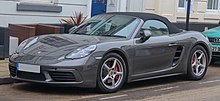
Porsche 718 Boxster S
With the new 982-generation, the marketing designation of the Boxster and Cayman was changed to Porsche 718, a nod to Porsche's racing heritage that won the Targa Florio race in 1959 and 1960. Because the 718 Cayman / Boxster has lost two cylinders, going from a naturally aspirated flat-6 engine to a turbocharged flat-4 engine, the name is meant to evoke a racing series that was won by a light car that outmaneuvered the cars with more powerful engines.[19][20]
The timeline of the 718 release started in 2016, with first model availability scheduled for June. The 718 base featured two new horizontally-opposed flat-4 turbocharged engines at 2.0L and 2.5L displacement with increased torque and horsepower with lower fuel consumption. The S model turbocharger utilizes Variable Turbine Geometry (VTG) technology.[21][22] Later, In October 2017 the GTS models were announced with their 2.5l engines upgraded to produce 361 bhp (269 kW). The Boxster could accelerate from 0–60 mph (97 km/h) in 4.1 seconds, and the Cayman in 3.9 seconds.[23]
The exterior of the 718 Boxster and Cayman is very similar to the third generation, in fact more of an evolution than a redesign. The most notable changes are to the rear of the car, which now has a long black-trim bar across the rear connecting the two taillights. The headlights and bumper are also heavily reworked. On the sides, the mirrors have been redesigned, taking hue from the SportDesign mirrors on the GT3.
The interior remains very similar to the 981 Cayman / Boxster and the 991.2 generation of the Porsche 911. The main change is the new PCM 4.0 infotainment system, which replaces the PCM 3.1.[24] The steering wheel comes with a mode selector switch that includes a selection of Sports and Sports Plus driving modes, resulting in snappier throttle response at the cost of fuel efficiency. Overall, the most prominent design features of the 981 Cayman / Boxster remain, including large air induction ports on the side, and the prominent horizontal aluminum piece used for adding oil and coolant in the trunk.[25]
Despite the loss of two cylinders, the 718 Cayman / Boxster are mechanically superior to the 981 model. Acceleration is faster, and steering is improved, while unfortunately the new engine "cheapens the experience".[26] The 718 Cayman was declared Motor Trend's 2nd best Drivers car in 2017, which praised the car's handling and throttle response. Giving the award, Miguel Cortina noted, "The suspension is just what you want to feel in a car like this—stiff, sporty, rigid. You get a very good sense of what is happening on the road."[27]
Boxster[edit]
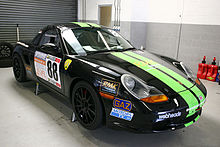
UK Race Boxster
- The Boxster has taken part in the Continental Tire Sports Car Challenge Street Tuner class.[28] A Boxster Spec racing series based on the early 1997–1999 2.5-liter models is organized by National Auto Sport Association (NASA).[29] The Porsche Club of America also has a Spec Boxster class, and uses the same rules as NASA.
- In the UK, Boxsters take part in the BRSCC Porsche Championship, in Spec or Production specification[30] and in the Porsche Club Championship.
Cayman[edit]
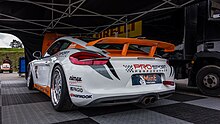
Porsche Cayman 981 SP GT4

Porsche Cayman GT4 Clubsport
- Jack Baldwin of GTSport Racing campaigns a Porsche Cayman S in the Pirelli World Challenge. GTSport Racing is the world's most successful Cayman program as Baldwin has scored 8 wins and over a dozen podium finishes in his Porsche Cayman S campaign, including two second place Championship finishes (2013, 2014) and one third place Championship finish (2012).
- Ernie Jakubowski won race 10 of the 2010 SCCA World Challenge event at Virginia International Raceway in the GTS class.[31]
- One-make Cayman Cup club racing championships are run in France[32] and Italy.[33]
- BGB Motorsports will be entering two Caymans in the 2010 Continental Challenge season.[34]
- The 2013 Rolex 24 Hours of Daytona, GX class was won by the Cayman, where it placed 1, 2 and 3. It was the Cayman platform's first endurance race in the U.S., the race was won by car number 16 of Napleton Racing, driven by David Donohue, Shane Lewis, Jim Norman, and Nelson Canache. Bullet Racing finished second and third place went to BGB. It gave Porsche its 75th class victory and the title of the marque with the most wins in the series.
- The Cayman GT4 Clubsport has raced since 2016 in the GT4 European Series, British GT Championship GT4-class, Dunlop Britcar Endurance Championship,[35] the Italian GT Championship in the Cayman-class, the Cayman GT4 Trophy by Manthey-Racing at the Nürburgring Nordschleife as part of the VLN endurance championship,[36] the 24 Hours Nürburgring, the Pirelli World Challenge GTS-class, the Continental Tire SportsCar Challenge GS-class, the 24H Series, and since 2017 in the FFSA GT Championship, Blancpain GT Series Asia GT4-class and Bathurst 12 Hour.
